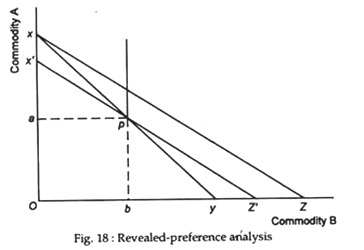In this article we will discuss about how consumption theory can be examined in terms of revealed preference approach.
The negative slope of the demand curve can be demonstrated from revealed preference approach. On the basis of the assumption that the consumer behaves consistently, we can show that the substitution effect of a change in the relative prices of commodities is always positive (if it is not zero). Let us assume that the budget-line XY in Fig. 18 represents all combinations of commodities A and B available to the consumer, given his income and the prices of the commodities.
We also assume that of all the combinations available to him the consumer chooses to consume Oa of commodity A and Ob of commodity B, the combination being represented by the point P. Now, there takes place a change in relative unchanged.
ADVERTISEMENTS:
This means that given the same income-level the consumer can still consume Os of commodity A by spending all his income on A. But he could now consume Oz of commodity B. His new budget line is, therefore, xz. Where on the net budget line will the consumer decide upon his combination of goods?
A fall in the price of a commodity is equivalent to an increase in real income of the consumer. In fact, the new budget line makes available to him more of both A and B from his given income. This is the income effect of a change in relative prices.
This income effect can be eliminated by moving the new budget-line xz parallel to itself towards the origin until it passes through point P, where the consumer is able to purchase his original combination of commodities, but at the new set of prices. This situation is represented by the line x’ z.
The consistency assumption now implies that on budget-line x’ z’ the consumer will reject combinations of goods represented by the part of the budget line x’p. The reason for this is that, these combinations of goods were previously available to the consumer on budget line xy and rejected by him in favour of combination p. So, p, in the new situation, where P is still available, he will choose P rather than a combination previously rejected.
ADVERTISEMENTS:
That part of the budget line pz’, however, represents combinations of goods which were not previously available to the consumer. It would, therefore, be quite consistent for him to choose some combination along that part of the new budget line.
This would mean consuming more of commodity B, whose price has fallen. Because we have eliminated the income effect, the choice of a combination of goods along pz’ is attributable to the substitution effect. It must be either zero or, if the consumer buys more of B as the price of A falls, positive. It cannot be negative on the assumption of consistency.
Restoring the income effect, and moving to the budget line xz, will normally ensure that more of B is consumed when its price falls. Hence, a point indicating the combination of goods chosen on the new budget line xz will normally be to the right of a vertical line through point P. So, the demand curve will be sloping downward to the right.
The revealed preference approach suggests that we can analyse a consumer’s behaviour directly. We can also derive his indifference curves from his actual choice.
